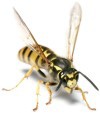Bees, Wasps, Hornets
Bees are rarely dangerous if left alone. They are major pollinators of flowering plants. You may see bees entering cavities under shake siding or nail holes. These are Mason bees and are not destructive. They are looking for a place to nest. Honey bees normally live in manufactured hives provided by bee-keepers.
Wasps take flight every spring. As soon as you detect a nest, call us. Don’t attempt to knock the nest down yourself, especially if you are allergic to stinging insects or not agile enough to escape if attacked. Nests are usually found under the eaves, in little-used alcoves and behind doors.
There are 3 wasp varieties:
- European Paper Wasp: this wasp is a pollinator and feeds on other insects. It only attacks if threatened.
- Yellow Jacket: these wasps are mistakenly called bees because they are similar in size and appearance. They don’t carry pollen and can sting repeatedly. At certain times of the year they are beneficial to homes and gardens because they prey on caterpillars, spiders and flies.
- Hornets: these wasps are the largest and most aggressive of the 3 and can sting repeatedly. They feed on the sap of oak trees, rotting sweet fruits and insects.
However, people do die from bites and stings. When a wasp or hornet nest is found near your home they can cause significant discomfort or an allergic reaction. Wasp, hornets and bees are extremely territorial.


